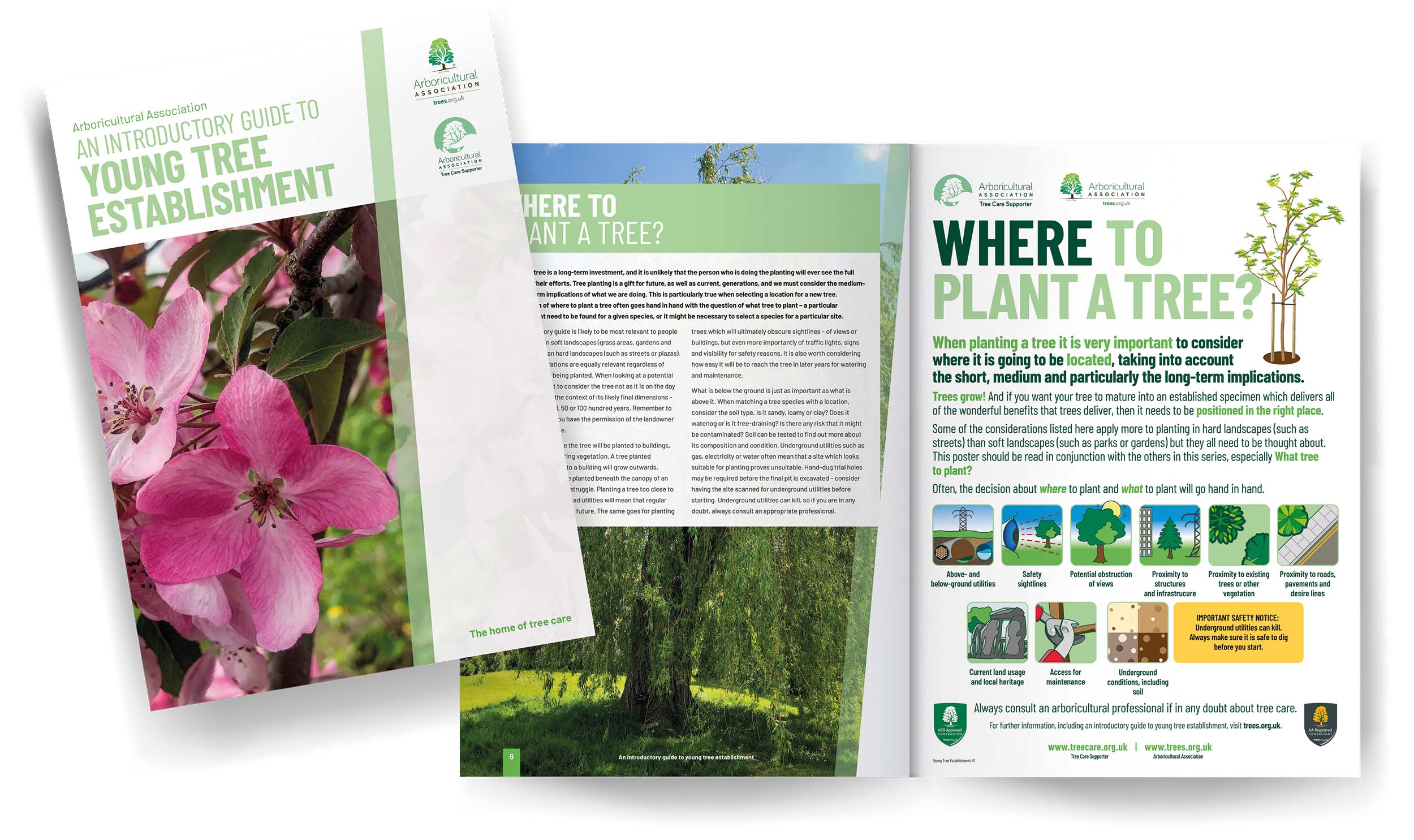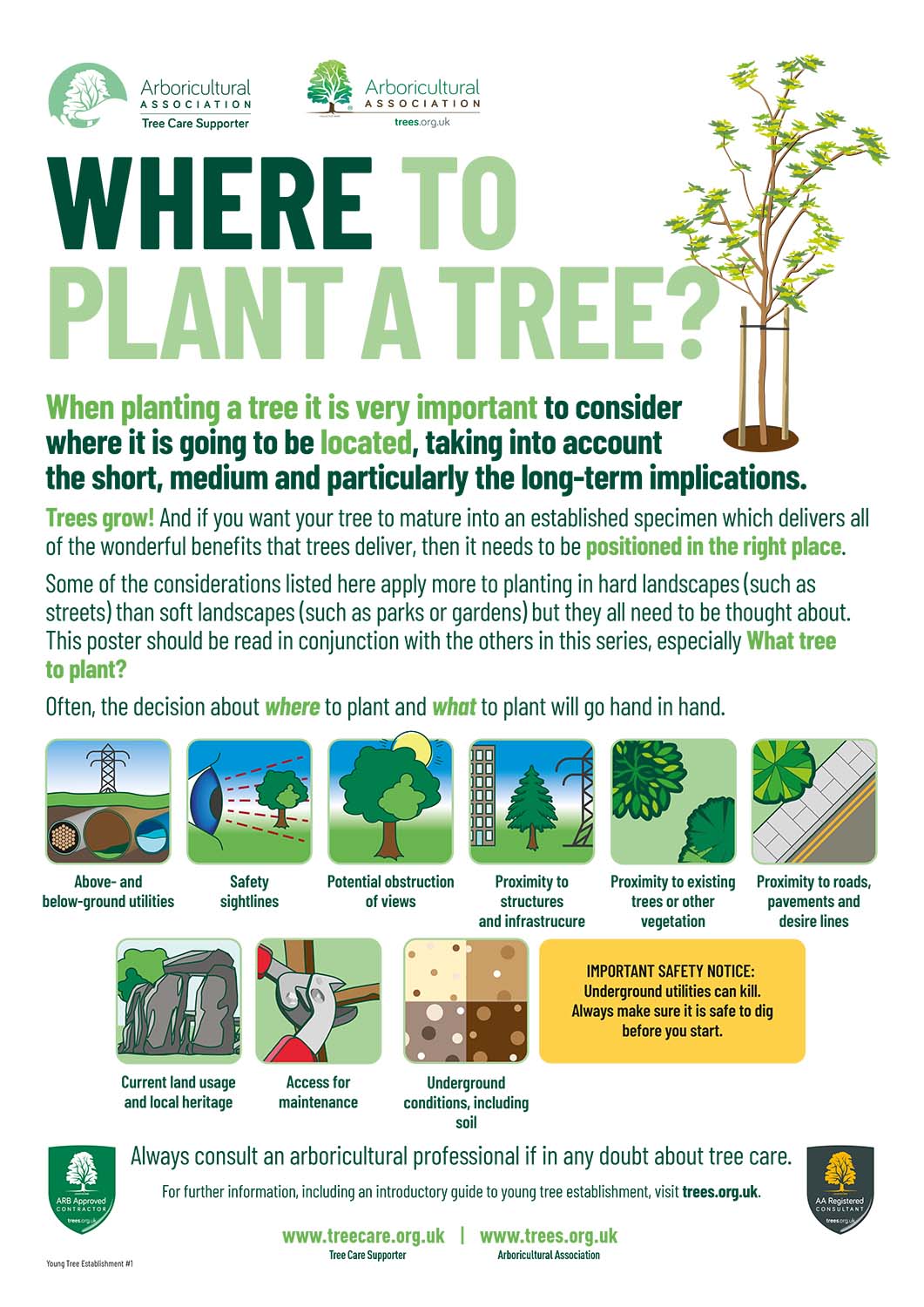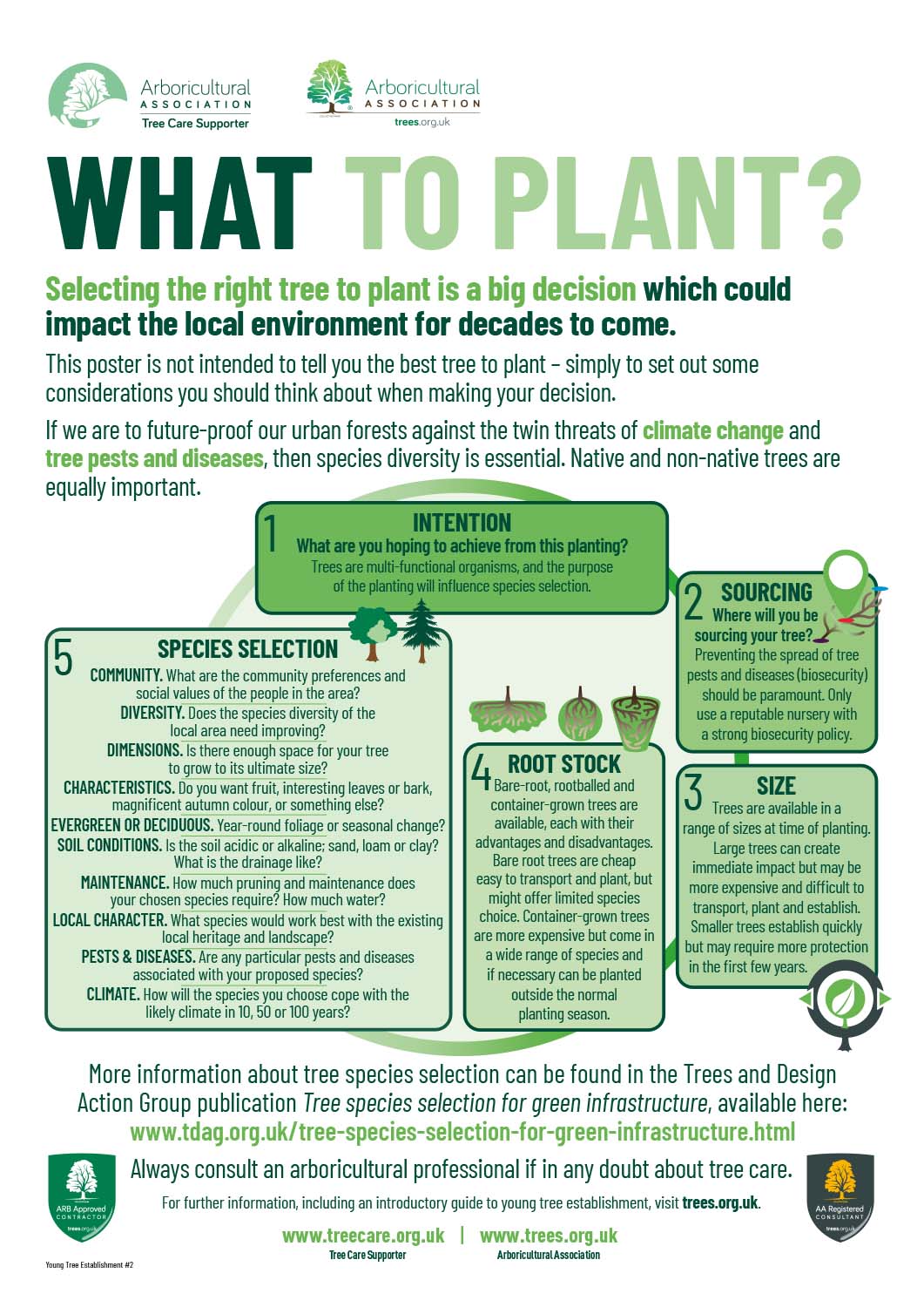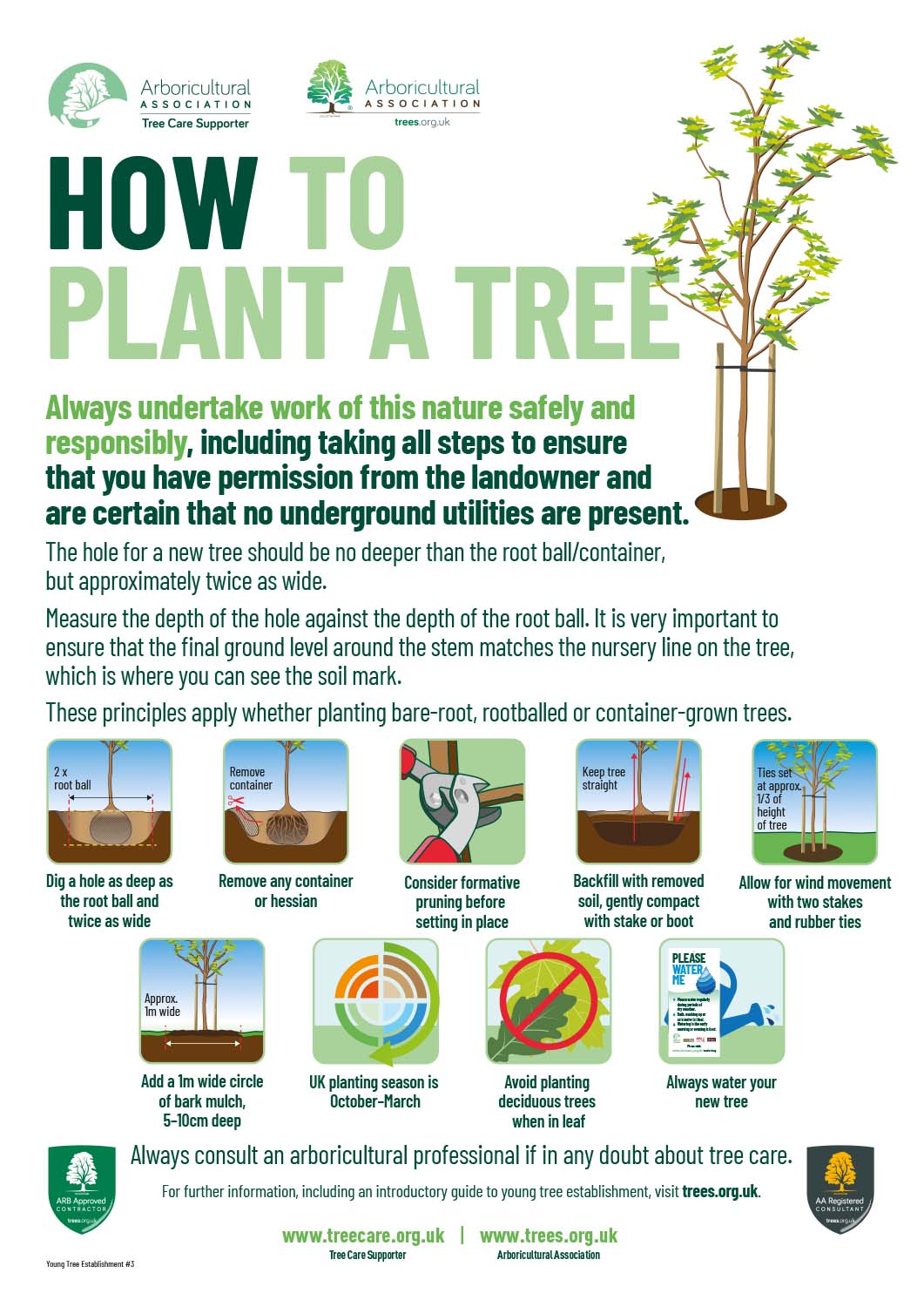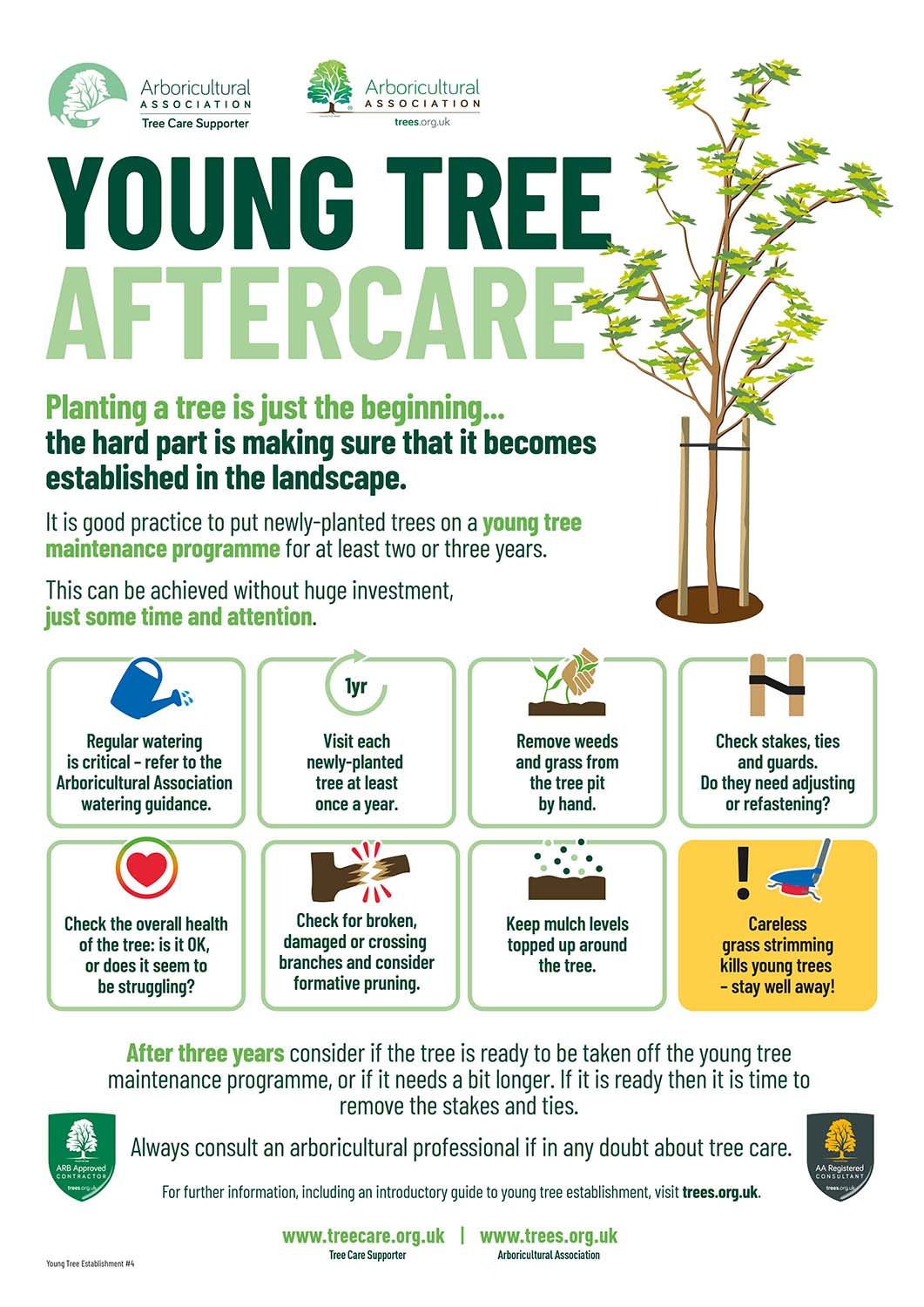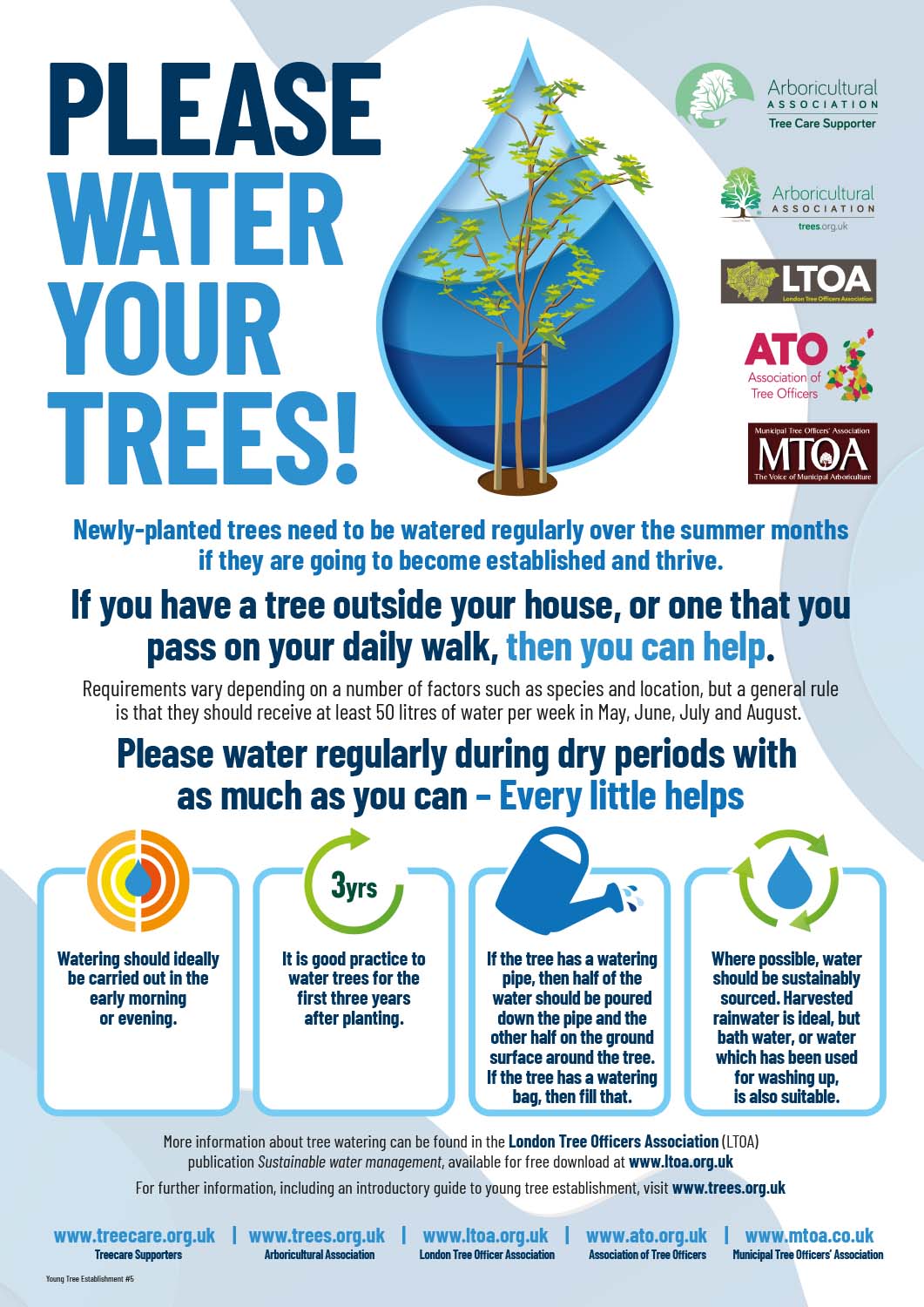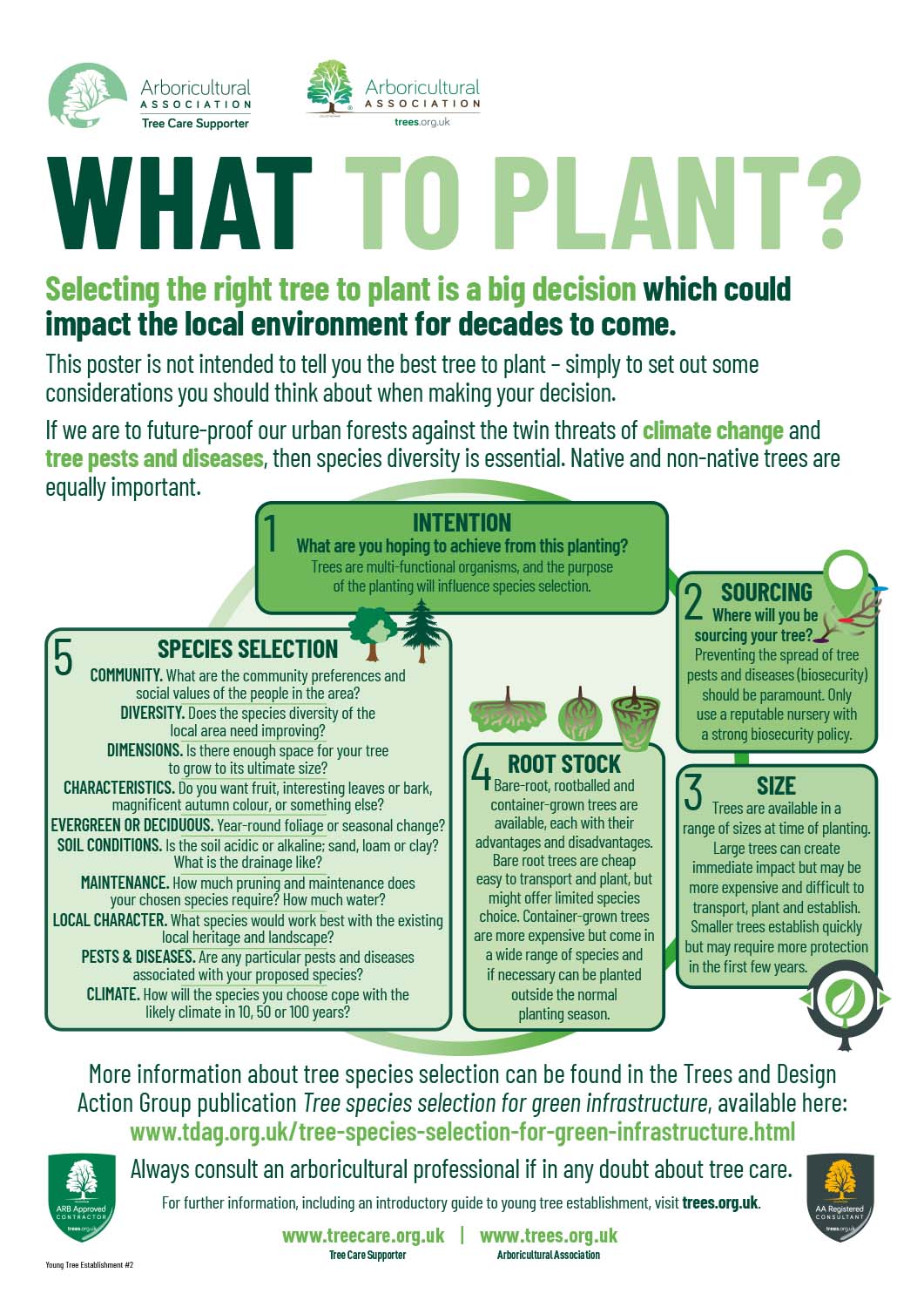Advice, ideas and signposting for the public
An Introductory Guide to Young Tree Establishment’ provides advice and ideas for a non-professional audience, as well as signposting readers towards other useful resources. It is not intended as a comprehensive guide, nor a replacement for specialist advice but is an important tool in sharing knowledge with the general public about arboriculture and tree care; communicating some of the key messages of the Association and hopefully helping people learn more about tree planting and aftercare.
Tree planting has never been more popular but planting a tree is just the start of the story. Arboriculturists work in tree time, not human lifespans or political cycles. If you consider the first 100 years of a tree’s life, then the act of planting might make up half an hour or so, or 0.000058%. It is undoubtedly a very important part of the process – a critical one – but there is so much more to the story…
The guide is available as a free download covering key areas including ‘Why plant a tree?’, ‘Where to plant a tree?’, ‘What tree to plant?’, ‘How to plant a tree’, ‘Young tree aftercare’ and ‘Tree watering’. Free downloadable posters for each section are also available.
In addition to the popular guides to tree watering and young tree aftercare launched over the past 18 months, the AA has produced two more posters aimed at educating the general public on tree care best practice.
The latest additions to the Young Tree Establishment suite of documents are ‘What to plant?’ and ‘Where to plant a tree’. They have been released as a pair, with the decision about what and where to plant often going hand in hand. The former sets out some considerations to take into account when deciding on species selection, while the latter focuses on the short, medium and particularly the long-term implications.
Following the successful introduction of the AA’s tree watering campaign in 2020, which has since been translated into several languages, the ‘Guide to Young Tree Aftercare’ was launched during National Tree Week in 2021, providing an easy-to-follow young tree maintenance programme for at least two or three years.
The downloadable guidance forms part of the Arboricultural Association’s Guide to Tree Establishment series.
You can view all four guides in full below and download the PDFs.
Young Tree Aftercare - Bark damage
A guide to some of the key things to remember after tree planting with John Parker, Technical Director of the Arboricultural Association.
Young Tree Aftercare - Mulching
John Parker talks us through some of the key points to focus on in the months and years after urban trees have been planted, in this example in a community park in Stonehouse, Gloucestershire as part of the Stonehouse in Bloom community project.
What is arboriculture?
The science and practice of the cultivation, establishment and management of amenity trees for the benefit of society.
Arboriculture refers to the care of trees grown or maintained for their amenity value – for the environmental, social and economic benefits that they bring – rather than for the value of their timber or fruit. It also involves tree safety and tree risk management, as many of the trees looked after by arboricultural professionals can be found in close proximity to people.
There are many different roles and careers in arboriculture. This includes nursery workers, groundspeople, tree surgeons, tree officers, consultants, researchers, trainers, policymakers and more.
There are close connections and links between arboriculture and other tree-related and environmental professions and disciplines such as woodland management, forestry and horticulture. However, despite some overlaps arboriculture is a profession in its own right, distinct in many ways from these other sectors.
Should Ivy be removed from trees?
For many years, gardeners and arborists alike would, as a matter of common tree maintenance, clear ivy from trees in order to remove the competition for light, water and nutrients, as well as the potential threat of the ivy totally smothering the tree.
However, in the light of increasing knowledge and research into the relationship between the plant and its host, it is now not considered an instant threat to the tree, and it is not necessary to remove it on a regular basis.
In certain circumstances (tree inspection, formal areas etc.) it is necessary to clear trees of ivy in order to carry out a detailed inspection of the condition of the tree, or to keep the appearance of the tree ‘tidy’. However, in many instances where trees are in a less strictly managed area, especially where wildlife conservation is the main aim, ivy does not need to be removed.
Habitat
Ivy is an attractive habitat for insects and invertebrates and consequently bird and animal life can benefit as a result of an increase in available food source. Bats, which are rare and protected by law regularly roost amongst ivy, as well as inside small cavities in suitable trees.
It would therefore depend on the main aims of the managers of the land in question as to whether the ivy is removed from the trees or it is left to provide a wildlife benefit.
If you need advice or tree management services - always use an Arb Approved Contractor (Tree work) or a Registered Consultant (Arboricultural consultant).
Young Tree Maintenance
Video Guide
Arboricultural Association Technical Director John Parker runs over some important basic young tree maintenance.
Preventing the introduction of harmful pests & diseases and the spread of exisiting issues
The Arboricultural Association works alongside many leading industry bodies to help promote best practice throughout both our membership but further afield too. To that end we have helped produce a Biosecurity Policy to help prevent spread on pests and diseases in our tree stock.
Biosecurity is the single most important subject in terms of safeguarding the future of our trees.
With the myriad of potential threats we aim to both give a clear best practice framework to those within the industry but also to help those with special interests around trees to be able to spot potential hazards and enable them to pass that information on to the relevant authorities.
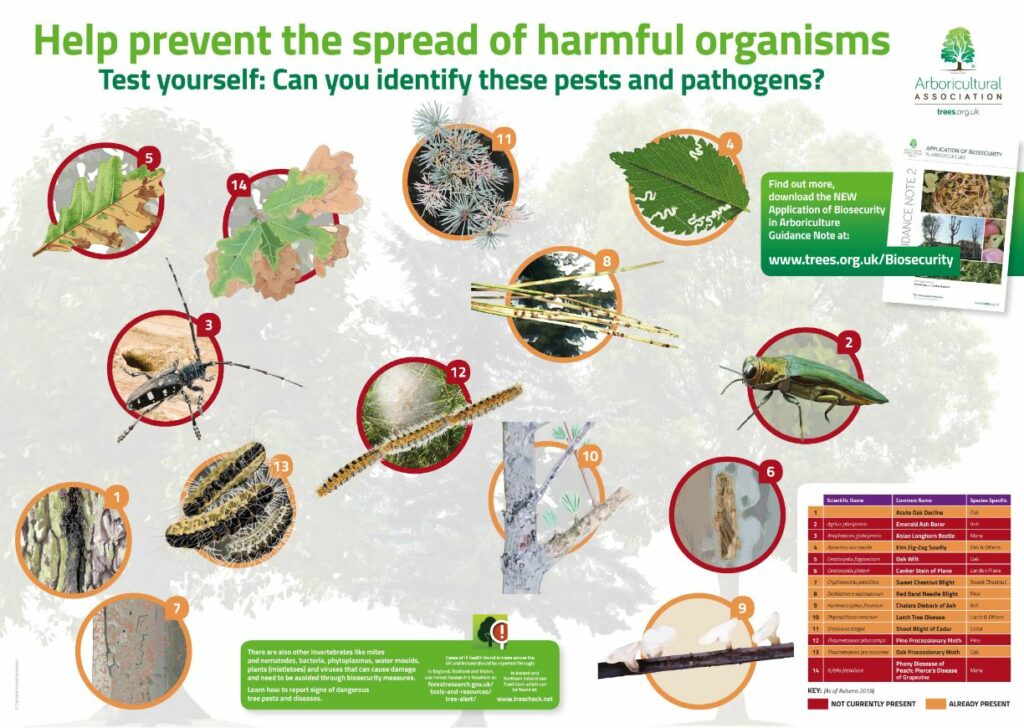
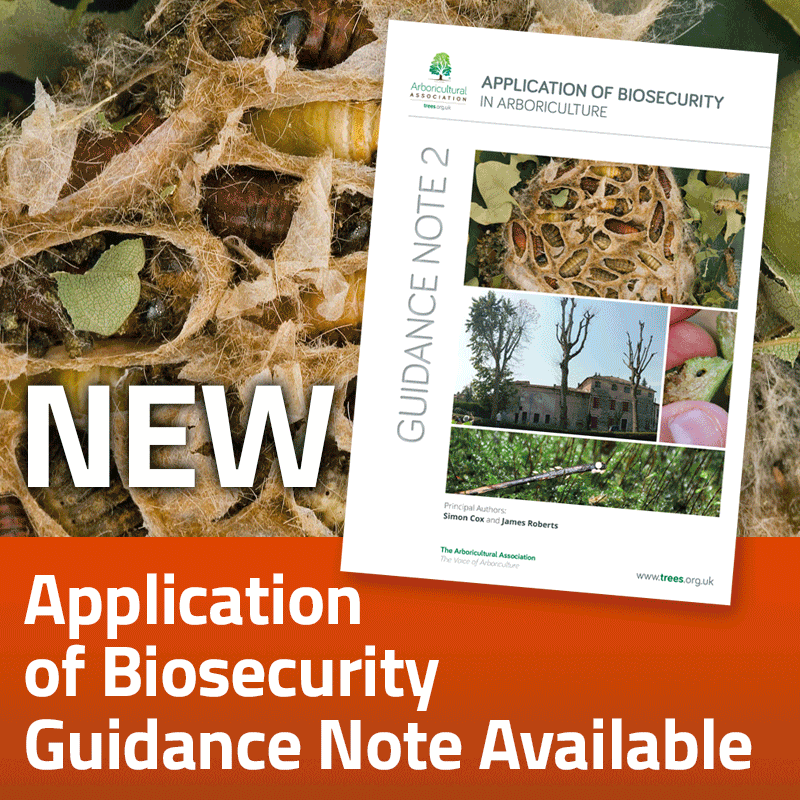
New Application of Biosecurity Guidance Note Available
Best practice guidance for Arborists working in any role in arboriculture and environmental sectors.
Equip yourself with the knowledge and tools to tackle biosecurity.
Guidance categorised by job roles from practical application to policy advisors.
Development near trees
Construction close to trees
Trees are easily damaged by construction works, regardless of their scale. Digging a garden pond may cause damage to trees in the same way as building demolition and construction.
It is important to ensure that trees are adequately assessed before ANY work takes place.
This is a complex topic. The specialists who can help you are:
- A competent Arboricultural Consultant
- An AA Registered Consultant
- Your Local Planning Authority
Trees near buildings and people
The proximity of trees to buildings can cause nuisance and inconvenience – for example through direct building damage, heavy shade or falling debris. Trees in adjacent property overhanging boundaries or blocking light are frequently a cause of annoyance or inconvenience, and there may be remedies available to alleviate this. For further advice contact a competent Arboricultural Consultant or a competent Arboricultural Contractor.
As a tree owner you have a legal duty of care to do what is reasonable to prevent harm being caused to others by your trees.
If located close to people or objects of value, the risks posed by the trees should be assessed by a competent Arboricultural Consultant. The frequency and level of this assessment will vary from location to location and tree to tree. On occasion, remedial work or tree removal might be required.
Building subsidence and heave
Occasionally trees can cause subsidence or heave damage to structures. If you notice cracks to your building, the first thing you should do is contact your building insurers who will investigate.
If agents for your neighbour’s house ask you to carry out work to your trees because of alleged damage the trees have caused, you should advise your own building insurers and if necessary instruct a competent Arboricultural Consultant and possibly a Structural Engineer to assess the situation.
Subsidence and heave require a multi-disciplinary approach, involving a range of professionals. The following professionals should be able to help you:
- A competent Arboricultural Consultant or AA Registered Consultant
- A competent Structural Engineer
- A competent Geotechnical Expert
- Your Buildings Insurance Company
Tree Selection, Planting and Maintenance
Selecting the right tree for the right place
Planting a tree in your garden is a decision requiring forethought and planning. Consideration must be given to the surrounding landscape and buildings, space available, soil type and location of the particular site.
Careful thought will help to ensure that an appropriate species is selected for the particular location, so giving the tree the best chance of successful establishment and future growth.
The Trees and Design Action Group (TDAG) offer comprehensive guidance with their resource Tree Species Selection for Green Infrastructure: A Guide for Specifiers, which includes information for over 280 species on their use-potential, size and crown characteristics, natural habitat, environmental tolerance, ornamental qualities, potential issues to be aware of, and notable varieties.
Further advice and information can be obtained from the Help & Advice section of this website as well as an AA Registered Consultant.
Tree planting
It is essential that young trees are given every opportunity to survive planting. Poor planting practices can result in long-term problems and even the death of the tree.
Information on how to plant your trees can be obtained from a competent Arboricultural Consultant, a competent Arboricultural Contractor, Specialist tree planting contractors or Tree nurseries.
Maintenance in the first few years following planting is crucial to ensure establishment. Young trees need TLC:
- Tending – check stakes, ties, guards and prune out broken and diseased branches
- Loosen ties and remove the stake altogether if the tree is stable
- Clear vegetation from around the base
- Add water when required
Tree maintenance
Most trees do not require regular pruning but there are occasions when tree work is necessary. You must take great care in deciding who you will take advice from.
Trees can suffer ill health from pests and diseases and or as a result of climatic or environmental changes.
If your tree looks unwell, appears different to normal or you consider that tree works might be required, you can obtain guidance and advice from the following sources:
- A competent Arboricultural Consultant
- A competent Arboricultural Contractor
- Download this leaflet – ‘Tree Work: Choosing your tree surgeon (arborist)’
- Download this leaflet – ‘Guide to Tree Pruning’
- Visit our Help & Advice section of this website
Tree Advice Trust Archive
The Arboricultural Association makes the archive of help and advice from the now defunct Tree Advice Trust accessible to all.
Trees in Focus
| Code | Title | Date |
|---|---|---|
| APN02 | Compost from Woody Wastes | 1996 |
| APN04 | Root Barriers and Building Subsidence | 1997 |
| APN05 | Shaded by Trees? | 1999 |
| APN06 | Trees and Shrubs for Noise Control | 2000 |
| APN07 | Grey Squirrels in Parks, Urban Woodlands and Amenity Plantings | 2003 |
| APN08 | Trees Bleeding | 2004 |
| APN09 | Management of Avenue Trees | 2004 |
| APN10 | Ivy – Boon or Bane? | 2004 |
| APN11 | Trees and Hedges in Dispute | 1997 |
| APN12 | Through the Trees to Development | 2007 |
| APN13 | Girdling, Constriction and Ring Barking | 2008 |
| Code | Title | Date |
The Board of the Association wishes to thank the Trust (and in particular Derek Patch) for the opportunity to share this material, which ensures the ongoing provision of impartial and authoritative information on tree matters.
The information thus made available was believed to be accurate at the time it was produced by the Trust, but neither the Association nor the Trust nor any existing or former board member or officer of either organisation takes any responsibility for its continuing accuracy or for its applicability in any particular situation. The Association will from time to time be reviewing how the material can most appropriately be updated and further disseminated.
Guide to Tree Pruning
Tree Pruning is part of a series of general information leaflets produced by the Arboricultural Association.
The Association provides membership services, accreditation and support to 3,000 professional arborists in the UK and further afield.
We strongly recommend that you use an accredited ARB Approved Contractor or AA Registered Consultant who has been vetted and approved by the Arboricultural Association.
You can find an accredited tree surgeon or consultant though our directories at www.trees.org.uk/Find-a-professional Please note the association is not able to provide direct advice to the general public.
How a tree works
Before we discuss pruning, we need to consider what a tree is and how it works. An appreciation of the processes involved in the growth of tree will help us to understand the principles behind pruning.
A tree is a dynamic living organism that has a self-supporting woody stem. Through the process of photosynthesis the tree converts carbon from the atmosphere into sugars, which it uses to make the building blocks of cellulose and lignin required to sustain its self-supporting structure. The sugars produced are transported throughout the tree via the inner bark area, known as the phloem, to where they are required; sugars not immediately required are stored within the trunk, branches and rooting system.
The tree roots absorb water and other essential nutrients and minerals from the soil, which are then transported to the leaves via tubular vessels called xylem. The minerals, along with the sugars produced via photosynthesis, are used to produce the flower and subsequently fruit to advance the next generation of trees.
Why prune your tree?
There are many reasons why trees might need pruning. These reasons could include improving the structure of the tree, to remove dangerous or defective branches; the reduction of shading, the reduction of wind loading or to provide clearance between the tree and a structure – to name just a few. Care must be taken however, as removing too big a branch can lead to disease entering the tree via the wound/s left behind, or reduce the vitality of tree due to the excessive volume of leaf bearing material being removed.
Before any branch is removed the following questions should be asked:
What will be the result of removing this branch?
Will it leave a large wound?
Will it remove a large area of leaf bearing material?
Will it leave the tree open to an increased risk of disease?
If the questions above can be answered with a “No” then the removal of the branch can proceed. It is very important to realise however, that the removal of tree branches can be a dangerous process and the safest option, particularly if the branch cannot be reached from the ground, is to employ a suitable trained and insured arborist (also known as a tree surgeon). A list of Arboricultural Association ARB Approved Contractors is available on our web site at www.trees.org.uk/Find-a-professional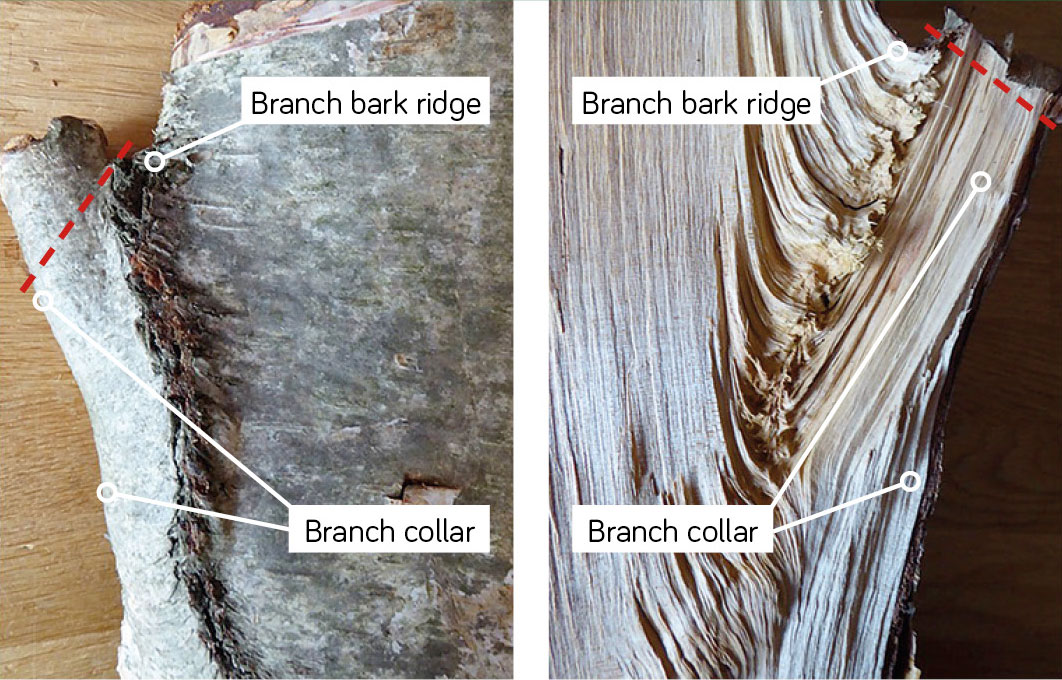
Figure 1 – Optimum position of the final pruning cut
How to prune a tree
Branches were once buds that became twigs, and over time and incremental growth, have gone on to form a branch. As the tree produces an annual ring of growth, so does the branch, strengthening the attachment of the branch to the tree. This attachment point will sometimes exhibit a strip of raised bark known as a ‘branch bark ridge’ on the top and sides of the branch and a ‘branch collar’, which is the area around the base of the branch.
To keep the wound as small as possible, the British Standard for tree work (BS 3998: 2010 Tree Work – Recommendations) states that the diameter of the final cut should not exceed one third of that of the parent branch or stem.
To remove the branch, a sequence of step cuts should be made with a shallow cut being made first on the underside leading to a top cut outside i.e. past, the underside cut. This will reduce the risk of the branch tearing down the stem and leaving an unsightly and potentially damaging wound; the final pruning cut can then be made at the branch bark ridge and branch collar.
When removing a branch, the final cut should be made from the branch bark ridge to the branch collar, along the red dotted line in figure 1. By following the imaginary red dotted line, the size of wound, in relation to the parent stem, will be left as small as possible. Some branches do not form a distinct branch collar, where this occurs, the cut should be made so as not to damage the branch bark ridge whilst leaving a small diameter wound.
If a large diameter branch is removed, the risk of disease entering the wound increases. Certain fungi and bacteria can enter the tree via these wounds and cause the woody structure of the tree to decay. Although decay is a normal process in terms of a trees life cycle, advancing this process by incorrect pruning can have serious consequences by compromising the health and structural integrity of the tree.
When to prune
If the decision has been made to prune or remove a branch, then a decision has to be made when to carry out the work. Pruning should generally occur after the leaves have ‘flushed’ and hardened, so late spring through summer. There are some exceptions, however, as some species such as Birch, Walnut and Maples, will ‘bleed’ sap and risk losing valuable sugars in the process if pruned in early spring, therefore the pruning of these trees should be carried out when this risk is low i.e. summer or mid winter.
Species belonging to the genus Prunus such as Cherry partially rely on the production of a resin or gum to aid in the defence against wound related pathogens, therefore pruning should occur in the summer. In general, pruning should avoid periods where the exposed wood will be left open to severe conditions such as drought, frost, and periods of fungal sporulation (autumn). Table 1 below gives the appropriate time to prune for a number of species commonly planted or found growing naturally within the United Kingdom and Northern Ireland and also indicates species specific tolerance to pruning. It should be noted that in most circumstances, unless there is a potentially hazardous structural defect that needs to be addressed, it is always best to prune trees as little as possible, as removing large amounts of wood and foliage reduces the ability of the tree to photosynthesise and can put the tree under significant stress.
Please note: Trees may be legally protected and unauthorised work can lead to prosecution. It is also your responsibility to ensure that protected wildlife is not harmed. Further advice can be found on our website at www.trees.org.uk/Help-and-Advice
| Species | Tolerance to hard pruning Good, Fair or Poor | Optimum time to prune | Notes |
|---|---|---|---|
| Deciduous trees | |||
| Acacia | Fair | Spring (late) | Living wood most obvious, dead can be easily identified |
| Ailanthus | Fair | Spring (late) to summer | |
| Alder | Fair | Spring (late) to summer | |
| Apple | Good | Winter (mid) | Prune every year for fruit production |
| Ash | Fair | Spring (late) to summer | |
| Beech | Poor | Spring (late) to summer | |
| Birch | Poor | Summer or winter (mid) | Prone to bleeding |
| Cherry (& other Prunus sp. e.g. Almond, Apricot, Peach, Plum) and Silver leaf. Avoid fungal sporulation period (autumn) | Fair | Summer | Prone to drought, frost damage |
| Elm | Good | Spring (late) to summer | |
| Eucalyptus | Poor | Spring (late) to summer | |
| Hornbeam | Poor | Spring (late) to summer | |
| Horse Chestnut | Good | Spring (late) to summer | Avoid if possible as regrowth is weak and heartwood is quick to decay |
| Lime | Good | Spring (late) to summer | |
| Magnolia | Fair | Summer (mid) | Reduces bleeding and allows time for healing to begin |
| Maples (inc Sycamore) | Fair | Summer or winter (mid) | Prone to bleeding (Field maple less susceptible) |
| Mulberry | Good | Winter (mid) | |
| Oak | Good | Spring (late)to summer | |
| Plane | Good | Spring (late)to summer | |
| Poplar | Good | Winter (mid) | Prone to bleeding |
| Robinia | Good | Summer (mid to late) | Prone to bleeding |
| Rowan | Fair | Spring (late) to summer | |
| Walnut | Poor | Summer or winter (mid) | Prone to bleeding |
| Whitebeam | Poor | Spring (late) to summer | |
| Willow | Good | Spring (late) to summer | |
| Evergreen trees | |||
| Cedars | Poor | Winter (mid to late) | Avoid any pruning if possible. Shoots will not grow from old wood – therefore prune lightly. |
| Cypresses | Poor | Spring (late) to summer (early) | Shoots will not grow from old wood – therefore prune lightly |
| Firs | Poor | Summer (late) or winter (late) | Avoid any pruning if possible. Shoots will not grow from old wood – therefore prune lightly |
| Hemlock | Fair | Summer (late) or winter (late) | |
| Holly | Fair | Winter (mid to late) | |
| Holm oak | Poor | Winter (mid to late) | |
| Pines | Poor | Spring (late) | Avoid any pruning if possible as buds only at shoot tips. Newest growth can be removed during the spring |
| Spruce | Poor | Summer (late) or winter (late) | Shoots will not grow from old wood – therefore prune lightly |
| Western red cedar | Fair | Winter (mid to late) | |
| Yew | Fair | Summer (late) or winter (late) |
How can I get a Tree Preservation Order made on a tree that I think is at risk of being felled or damaged?
Your local council is responsible for making Tree Preservation Orders (TPO). You should contact your local authority and speak to the tree officer or someone in the planning department who should determine whether the making of a TPO is appropriate.
More detailed information on TPOs: www.gov.uk/guidance/tree-preservation-orders-and-trees-in-conservation-areas#Flowchart-1-Making-and-confirming-TPO
What should I do if tree roots cause cracks in my driveway - does it mean that my house will be damaged next?
Tree roots typically grow close to the surface, and it is not uncommon for them to develop on the underside of hard surfaces such as driveways, which can lead to cracks developing through physical pressure.
This damage is frequently superficial, and there is a range of options available which include: do nothing; repair the cracks; remove the existing surface and replace with a new one engineered to accommodate the roots; prune the roots or remove the tree (the latter two subject to Tree Preservation Order (TPO) consent or conservation area notification if relevant).
Tree roots can cause problems by blocking drains. They do not usually cause the initial damage to the drain and will only enter drains which are already damaged and leaking. Therefore, if drains are watertight, roots should not normally affect them. If your drains are blocked by roots you will need a drainage company to assist. It is possible that the drains will require lining or replacing. Removing the tree seldom resolves the problem as the drain remains damaged and can leak (possibly causing foundation damage) or may be infiltrated by the roots of other plants unless the drain is repaired.
If your driveway or drains have been affected by roots, this does not necessarily mean that your house will be damaged next. Root damage to buildings is much rarer and is usually caused by subsidence: an entirely different mechanism to driveways and drains damage.
Further information:
- Tree Roots in the Built Environment 2006 (DCLG)
- Building Research Establishment publications
- AA Registered Consultants
- More detailed information on TPOs: www.gov.uk/guidance/tree-preservation-orders-and-trees-in-conservation-areas#Flowchart-1-Making-and-confirming-TPO
What is the minimum distance to plant trees from a house?
If the building work proposed requires planning consent, all trees which could potentially be affected by the development (including those off-site) should be assessed by an arboricultural consultant in accordance with British Standard BS5837 Trees in Relation to Construction – Recommendations, and details of this submitted to the Local Planning Authority with the planning application.
This assessment will consider tree condition, dimensions, likely retention span (years), and future growth potential, and will inform design in relation to how close you can build to trees. If the tree is to be retained, constraints to be considered are those below ground and above ground.
The below-ground constraints are dictated by the root protection area (RPA) the calculation of which is based on the stem diameter; the above ground constraints are dictated by the height and spread of the tree, future growth potential, shading potential and what you are proposing to construct.
Further information:
Root protection for veteran trees (Ancient Tree Forum)
What is a Root Protection Area and what does it mean?
How close to my house should a tree be?
In spite of what you may read in newspapers or be told by insurance companies, there are no fixed minimum recommended distances that you should plant trees of certain species from buildings.
When choosing a tree or trees to plant, you should give careful consideration to design, in particular how they will fit with their surroundings when they have reached their mature size. Young trees are frequently planted in spaces which are too small to allow them to grow to maturity, and a consequence of this is that they may be disliked as they develop, frequently resulting in heavy pruning or removal. Consequently, it is important to consider the ultimate size of the tree when choosing what and where to plant.
If you live in an area where there is heavy clay soil it is possible that trees in close proximity to buildings may cause structural damage to them by causing soil shrinkage which can lead to downward movement called subsidence. This is rare and cannot easily be predicted and there are many factors which affect it including the nature of the soil, tree characteristics, foundation design and climate. In areas of heavy clay soil where building foundations are known to be shallow this issue should be considered when deciding where to plant trees and how to manage existing trees – further advice should be sought as necessary.
Further information:

